WEAVE Gets Primed For On-Sky Commissioning
|
All the main components of the William Herschel Telescope Enhanced Area Velocity Explorer (WEAVE) – the positioner, fibres, spectrograph and detectors – have now arrived on La Palma and are being integrated with the telescope. After that, WEAVE will begin its on-sky commissioning phase. WEAVE will extend the telescope’s field of view to two degrees on the sky, or four times the apparent diameter of the Moon, allowing it to observe up to a thousand stars per hour and survey the sky over five years. It will enable scientists to follow up on ESA’s Gaia sources, and to study everything from white dwarfs in the neighbourhood of the Sun to the galaxies that host gravitational wave sources.
Scott Trager, WEAVE Project Scientist and chair of the WEAVE Survey Consortium, Kapteyn Astronomical Institute, University of Groningen said: “We are very excited to see WEAVE reach this important milestone. WEAVE will provide tens of millions of spectra of stars and galaxies over the coming five years, and the WEAVE Survey will provide data that will help answer questions like how did our galaxy form and the stars within it evolve, how were other galaxies assembled, and what are dark matter and dark energy?” Following a year of painstaking installation of close to 100 km of optical fibre assemblies WEAVE’s fibre positioner has made the journey from the UK, and has now been tested and calibrated (its arrival and upacking are documented in this photo sequence). The positioner is able to place full configurations of over 900 fibres in under one hour using its two high-speed industrial robots. Each fibre collects light from an individual star or galaxy and feeds it around the telescope structure to the spectrograph. Gavin Dalton, WEAVE Principal Investigator, University of Oxford and Science and Technology Facilities Council’s RAL Space, says: “It is tremendous to see the sustained efforts of so many groups of people coming together at the telescope, and to finally be able to bring the positioner system to operation. WEAVE has been ten years in development with many complex moving parts, and components developed in laboratories across Europe. With everything now at the Roque de los Muchachos Observatory we are on the cusp of offering astronomers a new and improved eye on the stars”. Marc Balcells, Director of the Isaac Newton Group of Telescopes (ING) said: “The ING initiated the project to build WEAVE, following extensive consultation with the international community served by the observatory. Our vision is to ensure that the WHT will continue to provide astronomers with the data they need to answer some of today’s most pressing questions about the Universe. It’s been exciting to build some parts of WEAVE, with firm support from STFC, and to begin testing, now that the hardware is undergoing final assembly and tuning. We are looking forward to on-sky commissioning and the start of the science surveys in a few months time”. |
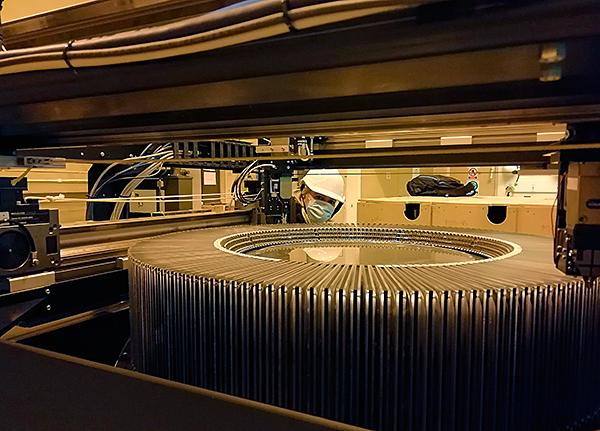 |
|
WEAVE’s fibre positioner after being unpacked at the WHT. In the centre of the image one of the MOS fibre plates can be seen, surrounded by three layers of parked fibre ends and, around these, the fin-like fibre-retractor boxes. Credit: Isaac Newton Group of Telescopes, La Palma. Large format: PNG.
|
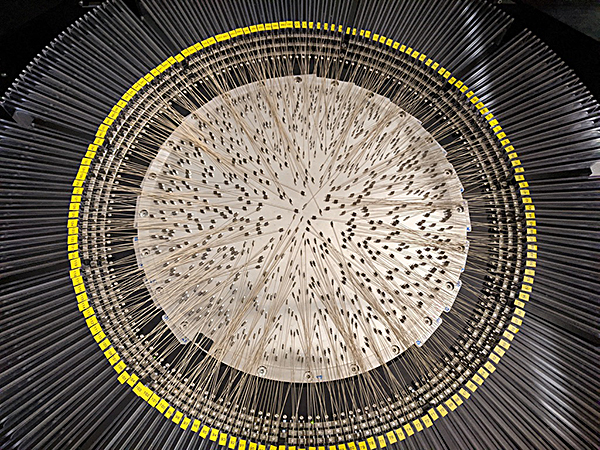 |
|
On-sky tests of the new prime-focus corrector (PFC) confirm that it delivers very sharp images, ensuring that in good seeing a given MOS fibre will collect 80% of the light from a target star, over a field of view 2 degrees, at all wavelengths from the ultra-violet to the far red. Following successful tests of the new PFC, and while integration of WEAVE proceeds at the WHT, one of the CMOS imagers used for the PFC tests has been offered to the community for science programmes. |
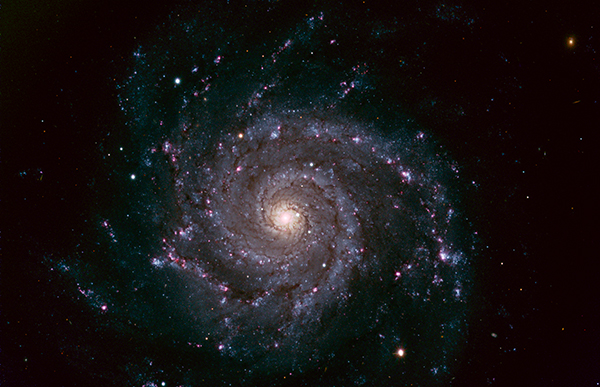 |
|
Image of M74 Galaxy obtained using PF-QHY on the WHT and R, G, B and Hα filters. Credit: Darío González Picos, Lara Monteagudo, Chris Benn and Ovidiu Vaduvescu. Large format: JPG.
|
|
The WEAVE spectrograph has already been installed at the WHT. It has two arms, each with its own custom-built cryostat – a liquid-nitrogen refrigeration unit which will cool the detectors to help limit background noise. Each cryostat houses a mosaic of two 6k × 6k CCD detectors, for a total of more than 150 megapixels to measure the spectra of stars and galaxies.
|
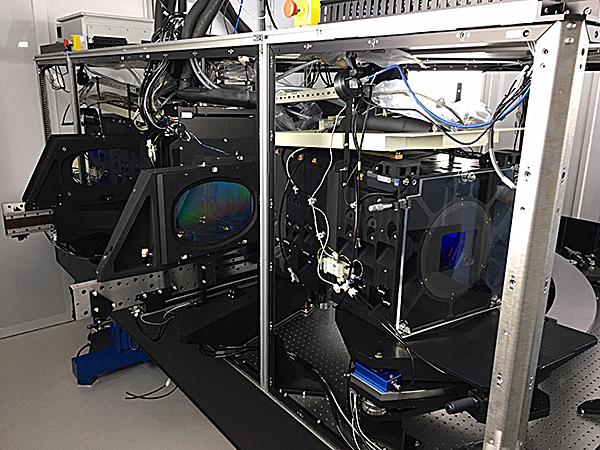 |
|
WEAVE’s spectrograph installed at the WHT. Credit: NOVA. Large format: PNG.
|
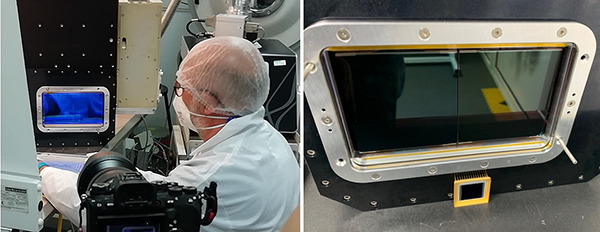 |
|
Left: One of the detectors being tested in ING’s laboratory. Right: one of the two 2-CCD mosaics seen behind the cryostat window, covering an impressive 20 x 12 cm area. Shown below the mosaic is the Tek3 detector, 4 x 4 cm, a ‘giant’ in the mid nineties. Large format: PNG. Credit: Isaac Newton Group of Telescopes, La Palma.
|
|
The on-sky commissioning of WEAVE will begin after integration of the instrument. It will last 2 – 3 months and will be followed by science-verification (SV) observations. After SV, ING will commence routine survey and open-time observing. Regarding the latter, the first allocations, from the International Time Programme (ITP), have already been awarded, and an announcement of opportunity for open time will be issued once the commissioning of WEAVE is finished.
The main components of WEAVE are:
WEAVE’s construction has been funded by the Science and Technology Facilities Council (UK), the Netherlands Research School for Astronomy (NOVA, NL), the Dutch Science Foundation (NWO, NL), The Isaac Newton Group of Telescope (ING, UK/NL/ES), the Astrophysical Institute of the Canaries (IAC, ES), the Ministry of Economy and Competitiveness (MINECO, ES), the Ministry of Science and Innovation (MCI), the European Regional Development Fund (ERDF), the National Institute for Astrophysics (INAF, IT), the French National Centre for Scientific Research (CNRS, FR), Paris Observatory – University of Paris Science and Letters (FR), Besançon Observatory (FR), Region île de France (F), Region Franche-Comté (FR), National Institute for Astrophysics, Optics and Electronics (INAOE, MX), National Council for Science and Technology (CONACYT, MX), Lund Observatory (SE), Uppsala University (SE), the Leibniz Institute AIP (DE), Max-Planck Institute for Astronomy (MPIA, DE), University of Pennsylvania (US), and Konkoly Observatory (HU).
The Isaac Newton Group of Telescopes is a unit of the Science and Technology Facilities Council (STFC) established on La Palma. It operates the William Herschel Telescope and the Isaac Newton Telescope with financial assistance from the Nederlandse Organisatie voor Wetenschappelijk Onderzoek (NWO) of the Netherlands, and the Instituto de AstrofÃsica de Canarias (IAC) in Spain. |









